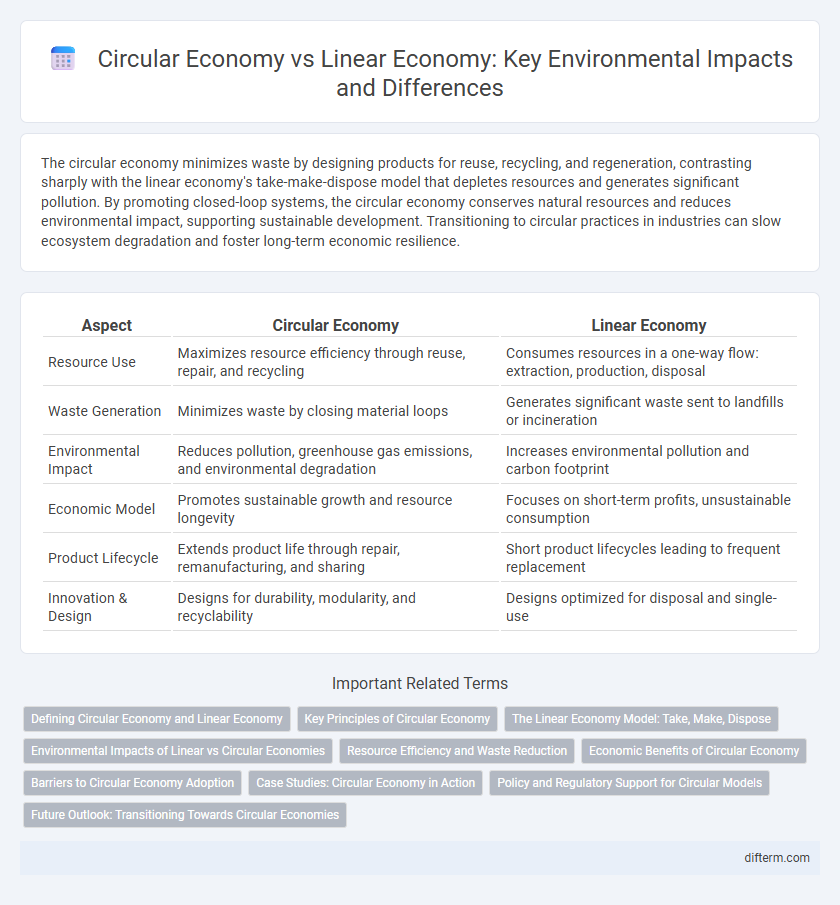The circular economy minimizes waste by designing products for reuse, recycling, and regeneration, contrasting sharply with the linear economy's take-make-dispose model that depletes resources and generates significant pollution. By promoting closed-loop systems, the circular economy conserves natural resources and reduces environmental impact, supporting sustainable development. Transitioning to circular practices in industries can slow ecosystem degradation and foster long-term economic resilience.
Table of Comparison
| Aspect | Circular Economy | Linear Economy |
|---|---|---|
| Resource Use | Maximizes resource efficiency through reuse, repair, and recycling | Consumes resources in a one-way flow: extraction, production, disposal |
| Waste Generation | Minimizes waste by closing material loops | Generates significant waste sent to landfills or incineration |
| Environmental Impact | Reduces pollution, greenhouse gas emissions, and environmental degradation | Increases environmental pollution and carbon footprint |
| Economic Model | Promotes sustainable growth and resource longevity | Focuses on short-term profits, unsustainable consumption |
| Product Lifecycle | Extends product life through repair, remanufacturing, and sharing | Short product lifecycles leading to frequent replacement |
| Innovation & Design | Designs for durability, modularity, and recyclability | Designs optimized for disposal and single-use |
Defining Circular Economy and Linear Economy
The circular economy is an economic system aimed at eliminating waste and continually using resources through recycling, reusing, and regenerating materials. In contrast, the linear economy follows a 'take-make-dispose' model where raw materials are extracted, transformed into products, and discarded after use, often contributing to environmental degradation. Emphasizing resource efficiency and sustainable lifecycle management, the circular economy reduces environmental impact and promotes long-term economic resilience.
Key Principles of Circular Economy
The circular economy focuses on key principles such as designing out waste and pollution, keeping products and materials in use, and regenerating natural systems. This approach contrasts with the linear economy's take-make-dispose model, which depletes resources and generates significant waste. By prioritizing resource efficiency and closed-loop cycles, the circular economy supports sustainable development and reduces environmental impact.
The Linear Economy Model: Take, Make, Dispose
The linear economy model follows a take-make-dispose approach, extracting raw materials to manufacture products that are eventually discarded as waste. This system leads to significant resource depletion and environmental pollution due to the lack of recycling or reuse mechanisms. Transitioning from linear to circular economy practices can reduce ecological impact by promoting resource efficiency and waste minimization.
Environmental Impacts of Linear vs Circular Economies
Linear economies generate substantial environmental impacts through resource depletion, greenhouse gas emissions, and excessive waste production. Circular economies minimize these effects by prioritizing reuse, recycling, and regeneration, thereby reducing raw material extraction and lowering carbon footprints. Studies indicate that adopting circular principles can decrease global emissions by up to 45% by 2050, promoting sustainable resource management and biodiversity conservation.
Resource Efficiency and Waste Reduction
Circular economy maximizes resource efficiency by continuously reusing and recycling materials, significantly reducing waste generation compared to the linear economy's take-make-dispose model. By designing products for longevity, repairability, and recyclability, circular systems minimize landfill contributions and environmental pollution. This approach enhances sustainable resource management and lowers the ecological footprint across industries.
Economic Benefits of Circular Economy
The circular economy generates substantial economic benefits by reducing material costs through reuse, repair, and recycling, thereby extending product lifecycles and minimizing waste. This model stimulates innovation, drives new business opportunities, and creates jobs in sustainable sectors, contributing to GDP growth. In contrast, the linear economy often incurs higher expenses due to resource depletion and waste management, making the circular approach more cost-effective and resilient long-term.
Barriers to Circular Economy Adoption
Limited access to funding and technology hinders the transition from a linear economy to a circular economy. Regulatory frameworks often lag behind the innovative models needed for circular practices, creating uncertainty for businesses. Consumer awareness and engagement remain low, reducing demand for sustainable products and slowing the market shift.
Case Studies: Circular Economy in Action
Case studies from cities like Amsterdam demonstrate the tangible benefits of circular economy models, including reduced waste and increased resource efficiency. Industry leaders such as IKEA implement closed-loop systems by recycling materials and designing products for disassembly, significantly lowering environmental impact. These examples highlight how shifting from a linear economy--characterized by take, make, dispose--to a circular economy fosters sustainable growth through continuous reuse and regeneration of materials.
Policy and Regulatory Support for Circular Models
Policy and regulatory frameworks play a critical role in advancing circular economy models by incentivizing sustainable production and waste reduction through extended producer responsibility and resource efficiency standards. Governments implementing strict regulations against single-use plastics and promoting product lifecycle assessments create a favorable environment for circular business practices. Financial incentives, such as tax credits and grants for circular innovation, further accelerate the transition from linear to circular economic systems.
Future Outlook: Transitioning Towards Circular Economies
Transitioning towards circular economies involves adopting regenerative design principles that minimize waste and maximize resource efficiency, thereby reducing environmental impact and fostering sustainable growth. Innovations in recycling technologies, product lifecycle management, and renewable energy integration are critical drivers enabling economies to shift from traditional linear models reliant on extraction and disposal. Emerging policies and global collaborations emphasize circular practices as pivotal for climate resilience, resource security, and achieving net-zero emissions by 2050.
circular economy vs linear economy Infographic

 difterm.com
difterm.com